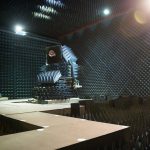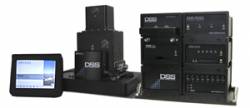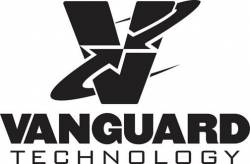Proceq GS8000 by Screening Eagle is a subsurface mapping system that combines the most advanced ground penetrating radar (GPR) technology with state-of-the-art GNSS positioning by u-blox, to produce real-time, easy-to-understand, 3D results.
Gorka Santamaria, Senior Product Manager, Geomatics at Screening Eagle, told Inside GNSS, “One of the things the GS8000 incorporates is access to u-blox’s PointPerfect corrections.” PointPerfect is u-blox’s advanced GNSS data augmentation service, designed to be accurate, reliable, and immediately available. “PointPerfect is part of the product,” Santamaria said, “not an option, not extra. To the customer this means survey-grade accuracy in a field that up to now has been working in GIS grade.”
Screening Eagle shared a space with u-blox at this year’s (2022) InterGEO in Essen. The company’s senior product manager, services, Stephane Vincent, said, “What you have inside this unit is a PointPerfect-compatible u-blox module, like the SAM-M10Q that you can see here. This is a very accurate GNSS receiver, so with the Proseq GS8000, we can go down to 10 meters, look underneath the street surface, look at pipes for the utilities market and have a very good position to combine withthe radar. We can work on archaeological sites, on all kinds of applications for GPR.”
Unlike traditional GPR devices, the GS8000 also detects small, near-surface objects such as metallic rebar or shallow cables, a capability that typically requires a handheld GPR device. This is possible thanks to the GS8000’s stepped frequency continuous wave (SFCW) GPR technology, operating on a wide range of frequencies (40-3440MHz).
Big step forward
“We’ve brought this industry up to high, centimetric precision, as default, out of the box,” said Santamaria, “as opposed to having to say, ‘oh, in case you want to work with precision positioning, you need to get a GNSS receiver from whoever, and then corrections from whoever, and then…’ all of that.”
Santamaria said Screening Eagle’s focus has also been on keeping things simple. “This system is easy to operate, for a user that is not necessarily familiar with all of the technical jargon. If you get lost sometimes with concepts like RTK, because it’s not your bread and butter, you will use this, get into our Freepath software, and get excellent results from day one.”
FreePath is a new software feature for the Proceq GS8000, combining PointPerfect corrected GPS location capabilities with the SFCW GPR data. This combination results in a subsurface mapping system with less than 5 cm accuracy. Operators can see their own positions on a map while collecting data in real time, so there is no longer a need for grid spacing or cross directional data collection.
“Traditional GPR typically will just give you these black and white, extremely complex images that you need a PhD to interpret,” Santamaria said,”. Then if you want to do some sort of mapping, like create a heat map, say, that’s an operation you would need to do in post processing. With any existing system on the market, you’d have to bring all the data back to the office and merge the positioning data with the GPR data. We bring it all together and produce a map that anybody can understand, as you walk.”
Proven popular
The GS8000’s unique capabilities have made it a success. “Oh yes, we are selling this,” Sanatmaria said, with a chuckle. “This product has been a blockbuster for us. We are operating in 120 countries as per today, so it’s very global extension, and the system is very well appreciated, not only in the traditional user base, but also in other segments.
“We are working on continuous improvement. You just have to look at how fast we have been moving. Within just a few months of launching our first GPR system, we incorporated all these real time options. We created a new methodology and software. This year we enabled it to work with robotic Total Stations, so that means it can also work indoors. We are absolutely focused on growing our solutions, and very much on the user experience. All actions are intuitive and super simple. This is not a tool for academics only, although academics and scientists can make the most of it.”






